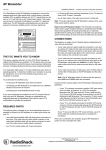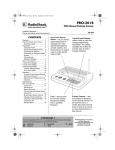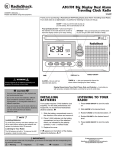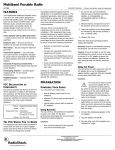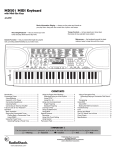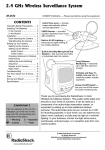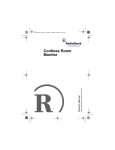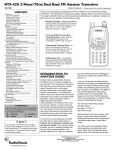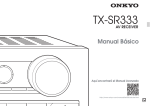Download Radio Shack 900MHz Owner`s manual
Transcript
43-3102.fm Page 1 Monday, May 13, 2002 10:01 AM ;22"/*\"9KTGNGUU"+PVGTEQOU 43-3102 OWNER’S MANUAL — Please read before using this equipment. #"+/2146#06"# If an icon appears at the end of a paragraph, go to the box on that page with the corresponding icon for pertinent information. Rý— Warning . — Caution ± — Note # — Important ° — Hint 6*'"(%%"9#065";17"61" -019 %106'065 The FCC Wants You to Know .... 1 Preparation ................................. 2 Installing Batteries ................... 2 Using AC Power ...................... 2 Using the Intercom’s Channels and Sub-Tones ........................ 3 Mounting the Intercoms .......... 4 Operation ................................... 5 Turning the Intercom On and Off/ Adjusting the Volume .............. 5 Calling Another Intercom ........ 5 Monitoring an Intercom ........... 5 Connecting an Audio Source .. 5 Care ........................................... 6 Service and Repair ..................... 7 Specifications ............................. 7 This equipment has been tested and found to comply with the limits for a Class B digital device, pursuant to Part 15 of the FCC Rules. These limits are designed to provide reasonable protection against harmful interference in a residential installation. This equipment generates, uses and can radiate radio frequency energy and, if not installed and used in accordance with the instructions, may cause harmful interference to radio communications. However, there is no guarantee that interference will not occur in a particular installation. If this equipment does cause harmful interference to radio or television reception, which can be determined by turning the equipment off and on, the user is encouraged to try to correct the interference by one or more of the following measures: • Reorient or relocate the receiving antenna. • Increase the separation between the equipment and receiver. © 2002 RadioShack Corporation. All Rights Reserved. RadioShack and RadioShack.com are trademarks used by RadioShack Corporation. 43-3102.fm Page 2 Monday, May 13, 2002 10:01 AM • R "9#40+0)ý R " Preparation Do not attempt to charge alkaline batteries. Nonrechargeable batteries can get hot or explode if you try to recharge them. • Never install non-rechargeable batteries when RECHARGE ON/OFF is set to ON. Nonrechargeable batteries can get hot or explode if you try to recharge them. • Dispose of old batteries promptly and properly. Do not burn or bury them. ."%#76+10". You must use a Class 2 power source that supplies regulated 9V DC and delivers at least 400 mA. Its center tip must be set to positive and its plug must fit the intercom's DC 9V jack. Using an adapter that does not meet these specifications could damage the intercoms or the adapter. ! • Connect the equipment into an outlet on a circuit different from that to which the receiver is connected. • Consult your local RadioShack store or an experienced radio/TV technician for help. • If you cannot eliminate the interference, the FCC requires that you stop using your intercoms. Changes or modifications not expressly approved by RadioShack may cause interference and void the user’s authority to operate the equipment. 24'2#4#6+10 +056#..+0)"$#66'4+'5 You can power your intercoms using four AA alkaline or rechargeable nickel-cadmium (Ni-Cd)/nickel-metal hydride (Ni-MH) batteries (not supplied). For the best performance and longest life, we recommend RadioShack batteries. Rý. 1. Slide the battery compartment cover on the back of the intercom in the direction of the arrow to remove it. 2. Slide RECHARGE ON/OFF to OFF (if you are installing alkaline batteries) or ON (if you are installing Ni-Cd or Ni-MH rechargeable batteries). • Use only fresh batteries of the required size and recommended type. 3. Place the batteries in the compartment as indicated by the polarity symbols (+ and –) marked inside. • Do not mix old and new batteries, different types of batteries (standard, alkaline, or rechargeable), or rechargeable batteries of different capacities. 4. Replace the cover. • • 2 If you do not plan to use the intercoms with batteries for a month or more, remove the batteries. Batteries can leak chemicals that can destroy electronic parts. Always connect the AC adapters to the intercoms before you connect them to AC power. When you finish, disconnect the adapters from AC power before you disconnect them from the intercoms. Once each intercom has been turned on and you connect its supplied AC adapter (see “Using AC Power”), rechargeable batteries (if installed) are automatically charged while the intercom is transmitting and standing by. The battery life for rechargeable batteries (Ni-MH, 1500mA) is about 37 hours. When POWER/BATT LOW flashes or the intercoms stop . operating properly, replace or recharge the batteries. Rý 75+0)"#%"219'4 You can power your intercoms using the supplied AC adapters. You can also use the AC adapters to charge rechargeable Ni-Cd or Ni-MH batteries you installed in the intercoms. . 43-3102.fm Page 3 Monday, May 13, 2002 10:01 AM 2. Plug the other end of the adapters into a standard AC outlet. Complete charging takes about 10 to 12 hours. Average charging time varies, depending on capacity. Typically, NiMH (1500 mA/H) batteries charge in about 12 hours. Ni-Cd (700 mA/H) batteries charge in about 4 hours. When charging is complete, unplug the AC adapter from the power source, then disconnect it from DC 9V. #" 75+0)"6*'"+06'4%1/N5"%*#00'.5"#0&" 57$/610'5 The intercoms use radio frequencies called channels to communicate with each other. Your intercoms have four channels. The intercoms also use sub-tones within the channels to help eliminate interference between intercoms, even if someone is using another intercom set to the same channel. Your intercoms have eight sub-tones. The channels and sub-tones let you set each intercom so they can: • communicate with each other #"+/2146#06"# Important: The EPA certified RBRC® Battery Recycling Seal on the nickel-cadmium (Ni-Cd) battery indicates RadioShack is voluntarily participating in an industry program to collect and recycle these batteries at the end of their useful life, when taken out of service in the United States or Canada. The RBRC program provides a convenient alternative to placing used Ni-Cd batteries into the trash or the municipal waste stream, which may be illegal in your area. Please call 1-800THE-SHACK (1-800-843-7422) for information on Ni-Cd battery recycling and disposal bans/ restrictions in your area. RadioShack’s involvement in this program is part of the company’s commitment to preserving our environment and conserving our natural resources. Preparation 1. Insert each AC adapter’s barrel plug into DC 9V on the top of each intercom. • communicate with additional intercoms you purchase. • not communicate with other intercoms For example, if you have more than two intercoms installed in your home, you can set them so the intercom you installed at the front door communicates only with the intercom you installed in the kitchen (so guests at the door can announce themselves to somebody working in the kitchen). You must set any two intercoms to the same channel and sub-tone for them to communicate with each other. 5GVVKPI"VJG"%JCPPGN"CPF"5WD/6QPG Each intercom has a group of DIP switches inside the battery compartment. Use an object such as a straightened paper clip to set the DIP switches. 1. On each intercom, slide the battery compartment cover on the back of the intercom in the direction of the arrow to remove it. 3 43-3102.fm Page 4 Monday, May 13, 2002 10:01 AM Preparation 2. For each intercom, select the channel you want to use by setting the last two DIP switches (labeled CH) inside the battery compartment to the channel you want to use. The chart on the right shows the positions to which you can set these DIP switches. 4 5 CH 1 2 3 4 • If you want all the intercoms to communicate with each other at the same time, set all intercoms to the same channel and sub-tone (see also Step 3). • If you want one intercom to communicate only with one other intercom, set only those two intercoms to the same channel and sub-tone. 1 2 3 1 2 3 SUB. TONE 3. For each intercom, select the sub-tone you want to use by setting the first three DIP switches (labeled SUB TONE) inside the battery compartment to the sub-tone you want to use. The chart on the right shows the positions to which you can set these DIP switches. 4 5 6 7 • If you want all the intercoms to 8 communicate with each other at the same time, set all intercoms to the same channel and sub-tone (see also Step 2). • If you receive interference on a channel you selected in Step 2, set each intercom to a different sub-tone. #"+/2146#06"# • Be sure you install the intercoms at least 10 feet away from each other. Placing the intercoms too close together produces feedback (a squeal or howl from the speakers). The intercoms can transmit up to 200 feet line of sight. • Be sure all intercoms you plan to use are turned on and adjusted to the desired volume. • Be sure both the intercom you are calling and the intercom you are using to make the call are set to the same channel and sub-tone (see “Setting the Channel and Sub-Tone” on Page 3). 4 /1706+0)"6*'"+06'4%1/5 You can place the intercoms on a desk or table, or mount them directly on a wall. To mount the intercoms on a wall, you need two screws for each intercom (not supplied), with heads that fit into the keyhole slots on the back of the intercom. For each intercom, follow these steps to mount it on a wall. 1. Drill a hole slightly smaller than the screws you are using to mount the intercoms, measure a length 315/16 inches (100 mm) from that hole, then drill a second hole. 2. Thread a screw into each hole, letting the left screw’s head extend about 1/4 inch (6.5 mm) from the wall and the right screw’s head about 1/8 inch (3.5 mm) from the wall. 3. Align the intercom’s keyhole slots with the mounting screws and slide the intercom down to secure it. 4. Lift and rotate the antenna up so it stands vertically. # 43-3102.fm Page 5 Monday, May 13, 2002 10:01 AM 12'4#6+10 6740+0)"6*'"+06'4%1/"10"#0&"1((1 #&,756+0)"6*'"81.7/' To turn on the intercom, rotate VOLUME counterclockwise until it clicks. POWER/BATT LOW lights. Then adjust VOLUME to a comfortable listening level. To turn off the intercom, rotate VOLUME clockwise until it clicks. POWER/BATT LOW turns off. %#..+0)"#016*'4"+06'4%1/"# Operation 1. Press CALL once. TRANSMIT lights. Each intercom that is on and set to the selected channel and sub-tone sounds a tone for about 3 seconds. 2. Hold down TALK and speak in a normal voice after you hear the beep. When you finish speaking, release TALK and listen for the response. ± /10+614+0)"#0"+06'4%1/ You can set any intercom so it continuously transmits sounds from the area where it is located to another intercom. You can monitor only one intercom at a time. ±"016'"±" Calling Another Intercom • 1. Press LOCK on the intercom in the area you want to monitor. TRANSMIT flashes. Only one party can talk on a channel at a time. • 2. When you finish monitoring, release the lock by pressing TALK on the intercom in the area you are monitoring. TRANSMIT turns off. TRANSMIT on the intercom you are using remains lit as long as you hold down TALK or CALL. • RECEIVE/BUSY lights when you receive a voice message or when you are monitoring a locked intercom. RECEIVE/ BUSY flashes if the channel is being used. After pressing LOCK on an intercom, you cannot call or talk to that intercom until you press TALK to release the lock. %100'%6+0)"#0"#7&+1"5174%'" Connecting a Standard Audio Source %QPPGEVKPI"C"5VCPFCTF"#WFKQ"5QWTEG If your audio source’s cable does not have the appropriate connector to attach to the intercom, use an adapter, available at your local RadioShack store or at RadioShack.com. To transmit audio to each intercom, you can connect one intercom to an optional audio source such as a radio, tape player, or CD player using an audio cable (not supplied). Then, when you turn on the audio source, the intercom where the audio source is connected broadcasts the sound to the other intercoms. ± 5 43-3102.fm Page 6 Monday, May 13, 2002 10:01 AM ."%#76+10". • • If you use the AUX broadcasting feature and also use the weather radio inputs, you MUST connect the Weatheradio alarm’s output to the unit that is using the AUX broadcasting feature. The weather radio inputs must not be connected to a unit that is RECEIVING the broadcast. Always connect the weather radio’s alarm output to the intercom you frequently use to broadcast. Care ±"016'"±" Connecting a Weather Radio • • If you connect an intercom to both a weather radio and an audio source and both sources are playing at the same time, the intercom always sounds the weather alert first. Both the RadioShack Cat. No. 12-250 and 12-258 Weatheradio (not supplied) have alarm output terminals you can use to connect to the intercoms. Listening to an Audio Source • Each intercom can broadcast from a connected audio source only when the channel to which it is set to is not being used to transmit voice from one intercom to another. • You can broadcast from only one intercom at a time. • Adjusting VOLUME on the intercoms does not change the intercom’s input sensitivity. • The intercom’s built-in ALC (automatic level control) circuitry keeps the input signal from overloading the transmitter. 6 Insert the cable’s plug into AUX INPUT on the top of the intercom, then connect the other end of the cable to the audio source’s output jack (such as AUX OUT or TAPE OUT). Follow the instructions in the owner’s manual for your audio equipment to play audio. %QPPGEVKPI"C"9GCVJGT"4CFKQ To transmit weather alerts to each intercom, you can connect one intercom to a weather radio’s alarm output terminal. This lets you hear any weather alerts on any intercom. Then, when a weather alert sounds, the intercom where the weather radio is connected broadcasts the alert to the other intercoms. Connect the WX INPUT terminals on the top of the intercom to your weather radio’s ALARM OUT terminals. Follow the instructions in the owner’s manual for your weather radio so it sounds a weather alarm using its alarm output terminals. ± To remove wires you connected to your intercom’s WX INPUT terminals, use a pointed object such as a straightened paper clip to press the orange tabs under the wires, then gently pull out the wires. .KUVGPKPI"VQ"CP"#WFKQ"5QWTEG To listen to a connected audio source or weather radio, turn on the connected audio source, then adjust VOLUME on each intercom to a comfortable listening level. When the input source signal stops, the intercom automatically resumes normal intercom mode. You cannot listen to a broadcast or Weatheradio while calling or talking until you turn off or disconnect the input signal. . %#4' Keep the intercoms dry; if they get wet, wipe them dry immediately. Use and store the intercoms only in normal temperature environments. Handle the intercoms carefully; do not drop them. Keep the intercoms away from dust and dirt, and wipe them with a damp cloth occasionally to keep them looking new. 43-3102.fm Page 7 Monday, May 13, 2002 10:01 AM 5'48+%'"#0&"4'2#+4 If your intercoms are not performing as they should, take them to your local RadioShack store for assistance. Modifying or tampering with the intercom’s internal components can cause a malfunction and might invalidate its warranty and void your FCC authorization to operate them. 52'%+(+%#6+105 Receiver Section 20 dB Quieting Sensitivity (Local) ............................................ 2 µV Frequency Accuracy ............................................................. 0 KHz Image Rejection (12dB SINAD) ............................................. 32 dB Spurious Rejection (12dB SINAD) ......................................... 40 dB Channel Selectivity ± 500KHz ............................................... 50 dB Squelch Threshold ..................................................... 20 dB SINAD S/N at 1mV input, ± 38KHz deviation (A-weight) (@ROP) .... 60 dB Distortion at 1K Hz, ± 38K Hz Deviation (@ROP) ..................... 1% 10% THD Output Power .................................................... 500 mW Current Drain at Reference Output ..................................... 160 mA Transmitter Section .............................................. +3 dBm Service and Repair RF Power Output at 50Ω Harmonic and Spurious Radiation Suppression .................... 40 dB MIC Input Sensitivity (@38 kHz Deviation) .......................... 2.5 mV AUX Input Sensitivity (@38 kHz Deviation) ........................ 150 mV Sub Tone Deviation ............................................................. 10 KHz Call Tone Deviation ............................................................. 35 KHz Alert Tone Deviation ............................................................ 32 KHz Total Harmonic Distortion ........................................................... 1% Current Drain ........................................................................ 55 mA General Performance Battery Low Indication ............................................................ 4.0 V Minimum Operation Voltage (Battery) ..................................... 3.5 V Operation Range (line of sight) .......................................... 200 feet Overall Frequency Response (–3 dB Bandwidth) ........ 300 - 10kHz Current Drain at Standby Mode ............................................ 18 mA Charging Time for 80% ....................................................... 10 hour Weather Alarm Input Sensitivity ................................................. 5 V VOX Sensitivity ..................................................................... 13 mV Specifications are typical; individual units might vary. Specifications are subject to change and improvement without notice. 7 43-3102.fm Page 8 Monday, May 13, 2002 10:01 AM Limited Ninety-Day Warranty This product is warranted by RadioShack against manufacturing defects in material and workmanship under normal use for ninety (90) days from the date of purchase from RadioShack companyowned stores and authorized RadioShack franchisees and dealers. EXCEPT AS PROVIDED HEREIN, RadioShack MAKES NO EXPRESS WARRANTIES AND ANY IMPLIED WARRANTIES, INCLUDING THOSE OF MERCHANTABILITY AND FITNESS FOR A PARTICULAR PURPOSE, ARE LIMITED IN DURATION TO THE DURATION OF THE WRITTEN LIMITED WARRANTIES CONTAINED HEREIN. EXCEPT AS PROVIDED HEREIN, RadioShack SHALL HAVE NO LIABILITY OR RESPONSIBILITY TO CUSTOMER OR ANY OTHER PERSON OR ENTITY WITH RESPECT TO ANY LIABILITY, LOSS OR DAMAGE CAUSED DIRECTLY OR INDIRECTLY BY USE OR PERFORMANCE OF THE PRODUCT OR ARISING OUT OF ANY BREACH OF THIS WARRANTY, INCLUDING, BUT NOT LIMITED TO, ANY DAMAGES RESULTING FROM INCONVENIENCE, LOSS OF TIME, DATA, PROPERTY, REVENUE, OR PROFIT OR ANY INDIRECT, SPECIAL, INCIDENTAL, OR CONSEQUENTIAL DAMAGES, EVEN IF RadioShack HAS BEEN ADVISED OF THE POSSIBILITY OF SUCH DAMAGES. Some states do not allow limitations on how long an implied warranty lasts or the exclusion or limitation of incidental or consequential damages, so the above limitations or exclusions may not apply to you. In the event of a product defect during the warranty period, take the product and the RadioShack sales receipt as proof of purchase date to any RadioShack store. RadioShack will, at its option, unless otherwise provided by law: (a) correct the defect by product repair without charge for parts and labor; (b) replace the product with one of the same or similar design; or (c) refund the purchase price. All replaced parts and products, and products on which a refund is made, become the property of RadioShack. New or reconditioned parts and products may be used in the performance of warranty service. Repaired or replaced parts and products are warranted for the remainder of the original warranty period. You will be charged for repair or replacement of the product made after the expiration of the warranty period. This warranty does not cover: (a) damage or failure caused by or attributable to acts of God, abuse, accident, misuse, improper or abnormal usage, failure to follow instructions, improper installation or maintenance, alteration, lightning or other incidence of excess voltage or current; (b) any repairs other than those provided by a RadioShack Authorized Service Facility; (c) consumables such as fuses or batteries; (d) cosmetic damage; (e) transportation, shipping or insurance costs; or (f) costs of product removal, installation, set-up service adjustment or reinstallation. This warranty gives you specific legal rights, and you may also have other rights which vary from state to state. RadioShack Customer Relations, 200 Taylor Street, 6th Floor, Fort Worth, TX 76102 12/99 RadioShack Corporation Fort Worth, Texas 76102 43-3102 AO0089AAA1 04A02 Printed in China








